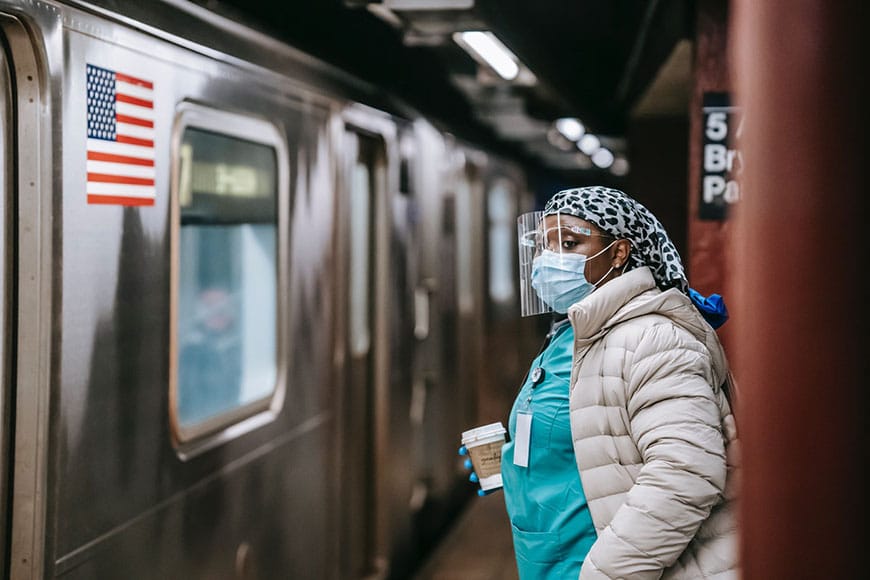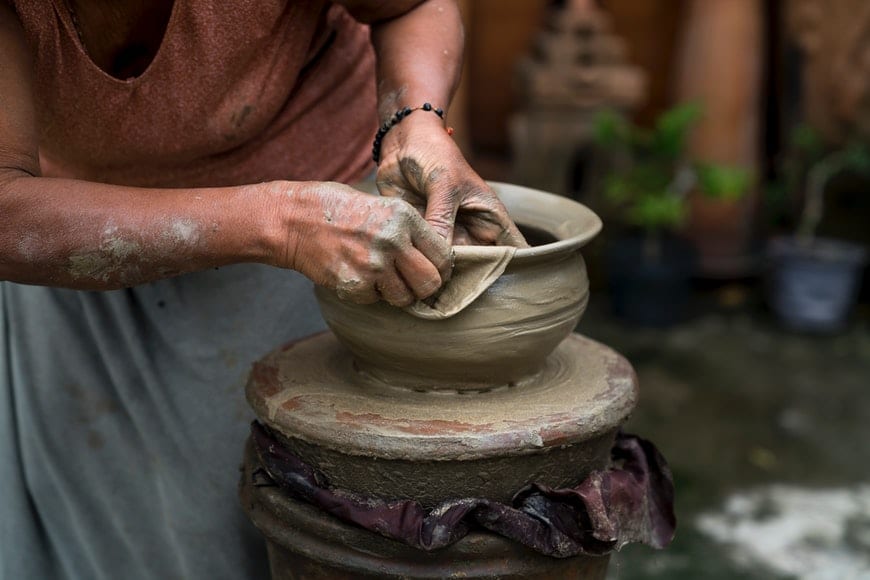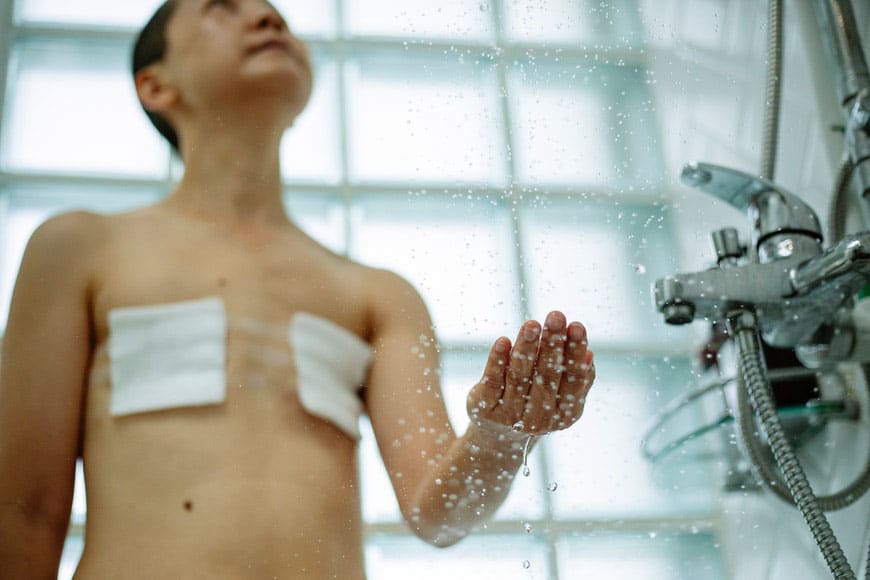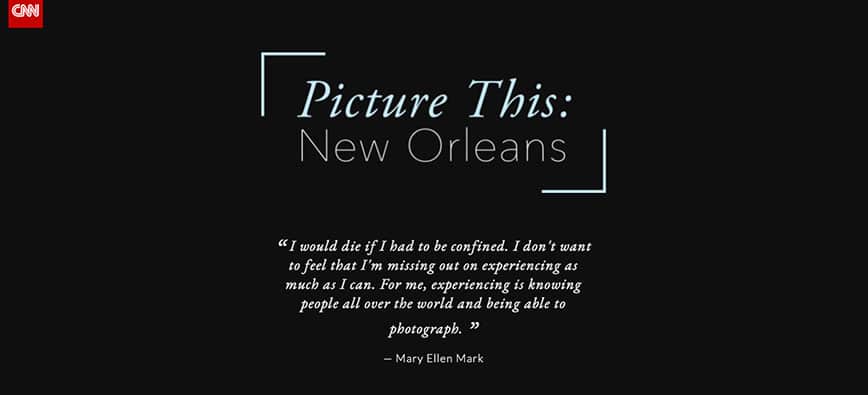The leading authority in photography and camera gear.
Become a better photographer.
12.9 Million
Annual Readers
Newsletter Subscribers
Featured Photographers
Photography Guides & Gear Reviews


How to Create an Engaging Photo Essay (with Examples)
Photo essays tell a story in pictures. They're a great way to improve at photography and story-telling skills at once. Learn how to do create a great one.
Learn | Photography Guides | By Ana Mireles
Shotkit may earn a commission on affiliate links. Learn more.
Photography is a medium used to tell stories – sometimes they are told in one picture, sometimes you need a whole series. Those series can be photo essays.
If you’ve never done a photo essay before, or you’re simply struggling to find your next project, this article will be of help. I’ll be showing you what a photo essay is and how to go about doing one.
You’ll also find plenty of photo essay ideas and some famous photo essay examples from recent times that will serve you as inspiration.
If you’re ready to get started, let’s jump right in!
Table of Contents
What is a Photo Essay?
A photo essay is a series of images that share an overarching theme as well as a visual and technical coherence to tell a story. Some people refer to a photo essay as a photo series or a photo story – this often happens in photography competitions.
Photographic history is full of famous photo essays. Think about The Great Depression by Dorothea Lange, Like Brother Like Sister by Wolfgang Tillmans, Gandhi’s funeral by Henri Cartier Bresson, amongst others.
What are the types of photo essay?
Despite popular belief, the type of photo essay doesn’t depend on the type of photography that you do – in other words, journalism, documentary, fine art, or any other photographic genre is not a type of photo essay.
Instead, there are two main types of photo essays: narrative and thematic .
As you have probably already guessed, the thematic one presents images pulled together by a topic – for example, global warming. The images can be about animals and nature as well as natural disasters devastating cities. They can happen all over the world or in the same location, and they can be captured in different moments in time – there’s a lot of flexibility.
A narrative photo essa y, on the other hand, tells the story of a character (human or not), portraying a place or an event. For example, a narrative photo essay on coffee would document the process from the planting and harvesting – to the roasting and grinding until it reaches your morning cup.
What are some of the key elements of a photo essay?
- Tell a unique story – A unique story doesn’t mean that you have to photograph something that nobody has done before – that would be almost impossible! It means that you should consider what you’re bringing to the table on a particular topic.
- Put yourself into the work – One of the best ways to make a compelling photo essay is by adding your point of view, which can only be done with your life experiences and the way you see the world.
- Add depth to the concept – The best photo essays are the ones that go past the obvious and dig deeper in the story, going behind the scenes, or examining a day in the life of the subject matter – that’s what pulls in the spectator.
- Nail the technique – Even if the concept and the story are the most important part of a photo essay, it won’t have the same success if it’s poorly executed.
- Build a structure – A photo essay is about telling a thought-provoking story – so, think about it in a narrative way. Which images are going to introduce the topic? Which ones represent a climax? How is it going to end – how do you want the viewer to feel after seeing your photo series?
- Make strong choices – If you really want to convey an emotion and a unique point of view, you’re going to need to make some hard decisions. Which light are you using? Which lens? How many images will there be in the series? etc., and most importantly for a great photo essay is the why behind those choices.
9 Tips for Creating a Photo Essay

Credit: Laura James
1. Choose something you know
To make a good photo essay, you don’t need to travel to an exotic location or document a civil war – I mean, it’s great if you can, but you can start close to home.
Depending on the type of photography you do and the topic you’re looking for in your photographic essay, you can photograph a local event or visit an abandoned building outside your town.
It will be much easier for you to find a unique perspective and tell a better story if you’re already familiar with the subject. Also, consider that you might have to return a few times to the same location to get all the photos you need.
2. Follow your passion
Most photo essays take dedication and passion. If you choose a subject that might be easy, but you’re not really into it – the results won’t be as exciting. Taking photos will always be easier and more fun if you’re covering something you’re passionate about.
3. Take your time
A great photo essay is not done in a few hours. You need to put in the time to research it, conceptualizing it, editing, etc. That’s why I previously recommended following your passion because it takes a lot of dedication, and if you’re not passionate about it – it’s difficult to push through.
4. Write a summary or statement
Photo essays are always accompanied by some text. You can do this in the form of an introduction, write captions for each photo or write it as a conclusion. That’s up to you and how you want to present the work.
5. Learn from the masters
Making a photographic essay takes a lot of practice and knowledge. A great way to become a better photographer and improve your storytelling skills is by studying the work of others. You can go to art shows, review books and magazines and look at the winners in photo contests – most of the time, there’s a category for photo series.
6. Get a wide variety of photos
Think about a story – a literary one. It usually tells you where the story is happening, who is the main character, and it gives you a few details to make you engage with it, right?
The same thing happens with a visual story in a photo essay – you can do some wide-angle shots to establish the scenes and some close-ups to show the details. Make a shot list to ensure you cover all the different angles.
Some of your pictures should guide the viewer in, while others are more climatic and regard the experience they are taking out of your photos.
7. Follow a consistent look
Both in style and aesthetics, all the images in your series need to be coherent. You can achieve this in different ways, from the choice of lighting, the mood, the post-processing, etc.
8. Be self-critical
Once you have all the photos, make sure you edit them with a good dose of self-criticism. Not all the pictures that you took belong in the photo essay. Choose only the best ones and make sure they tell the full story.
9. Ask for constructive feedback
Often, when we’re working on a photo essay project for a long time, everything makes perfect sense in our heads. However, someone outside the project might not be getting the idea. It’s important that you get honest and constructive criticism to improve your photography.
How to Create a Photo Essay in 5 Steps

Credit: Quang Nguyen Vinh
1. Choose your topic
This is the first step that you need to take to decide if your photo essay is going to be narrative or thematic. Then, choose what is it going to be about?
Ideally, it should be something that you’re interested in, that you have something to say about it, and it can connect with other people.
2. Research your topic
To tell a good story about something, you need to be familiar with that something. This is especially true when you want to go deeper and make a compelling photo essay. Day in the life photo essays are a popular choice, since often, these can be performed with friends and family, whom you already should know well.
3. Plan your photoshoot
Depending on what you’re photographing, this step can be very different from one project to the next. For a fine art project, you might need to find a location, props, models, a shot list, etc., while a documentary photo essay is about planning the best time to do the photos, what gear to bring with you, finding a local guide, etc.
Every photo essay will need different planning, so before taking pictures, put in the required time to get things right.
4. Experiment
It’s one thing to plan your photo shoot and having a shot list that you have to get, or else the photo essay won’t be complete. It’s another thing to miss out on some amazing photo opportunities that you couldn’t foresee.
So, be prepared but also stay open-minded and experiment with different settings, different perspectives, etc.
5. Make a final selection
Editing your work can be one of the hardest parts of doing a photo essay. Sometimes we can be overly critical, and others, we get attached to bad photos because we put a lot of effort into them or we had a great time doing them.
Try to be as objective as possible, don’t be afraid to ask for opinions and make various revisions before settling down on a final cut.
7 Photo Essay Topics, Ideas & Examples

Credit: Michelle Leman
- Architectural photo essay
Using architecture as your main subject, there are tons of photo essay ideas that you can do. For some inspiration, you can check out the work of Francisco Marin – who was trained as an architect and then turned to photography to “explore a different way to perceive things”.
You can also lookup Luisa Lambri. Amongst her series, you’ll find many photo essay examples in which architecture is the subject she uses to explore the relationship between photography and space.
- Process and transformation photo essay
This is one of the best photo essay topics for beginners because the story tells itself. Pick something that has a beginning and an end, for example, pregnancy, the metamorphosis of a butterfly, the life-cycle of a plant, etc.
Keep in mind that these topics are linear and give you an easy way into the narrative flow – however, it might be difficult to find an interesting perspective and a unique point of view.
- A day in the life of ‘X’ photo essay
There are tons of interesting photo essay ideas in this category – you can follow around a celebrity, a worker, your child, etc. You don’t even have to do it about a human subject – think about doing a photo essay about a day in the life of a racing horse, for example – find something that’s interesting for you.
- Time passing by photo essay
It can be a natural site or a landmark photo essay – whatever is close to you will work best as you’ll need to come back multiple times to capture time passing by. For example, how this place changes throughout the seasons or maybe even over the years.
A fun option if you live with family is to document a birthday party each year, seeing how the subject changes over time. This can be combined with a transformation essay or sorts, documenting the changes in interpersonal relationships over time.
- Travel photo essay
Do you want to make the jump from tourist snapshots into a travel photo essay? Research the place you’re going to be travelling to. Then, choose a topic.
If you’re having trouble with how to do this, check out any travel magazine – National Geographic, for example. They won’t do a generic article about Texas – they do an article about the beach life on the Texas Gulf Coast and another one about the diverse flavors of Texas.
The more specific you get, the deeper you can go with the story.
- Socio-political issues photo essay
This is one of the most popular photo essay examples – it falls under the category of photojournalism or documental photography. They are usually thematic, although it’s also possible to do a narrative one.
Depending on your topic of interest, you can choose topics that involve nature – for example, document the effects of global warming. Another idea is to photograph protests or make an education photo essay.
It doesn’t have to be a big global issue; you can choose something specific to your community – are there too many stray dogs? Make a photo essay about a local animal shelter. The topics are endless.
- Behind the scenes photo essay
A behind-the-scenes always make for a good photo story – people are curious to know what happens and how everything comes together before a show.
Depending on your own interests, this can be a photo essay about a fashion show, a theatre play, a concert, and so on. You’ll probably need to get some permissions, though, not only to shoot but also to showcase or publish those images.
4 Best Photo Essays in Recent times
Now that you know all the techniques about it, it might be helpful to look at some photo essay examples to see how you can put the concept into practice. Here are some famous photo essays from recent times to give you some inspiration.
Habibi by Antonio Faccilongo
This photo essay wan the World Press Photo Story of the Year in 2021. Faccilongo explores a very big conflict from a very specific and intimate point of view – how the Israeli-Palestinian war affects the families.
He chose to use a square format because it allows him to give order to things and eliminate unnecessary elements in his pictures.
With this long-term photo essay, he wanted to highlight the sense of absence and melancholy women and families feel towards their husbands away at war.
The project then became a book edited by Sarah Leen and the graphics of Ramon Pez.

Picture This: New Orleans by Mary Ellen Mark
The last assignment before her passing, Mary Ellen Mark travelled to New Orleans to register the city after a decade after Hurricane Katrina.
The images of the project “bring to life the rebirth and resilience of the people at the heart of this tale”, – says CNNMoney, commissioner of the work.
Each survivor of the hurricane has a story, and Mary Ellen Mark was there to record it. Some of them have heartbreaking stories about everything they had to leave behind.
Others have a story of hope – like Sam and Ben, two eight-year-olds born from frozen embryos kept in a hospital that lost power supply during the hurricane, yet they managed to survive.

Selfie by Cindy Sherman
Cindy Sherman is an American photographer whose work is mainly done through self-portraits. With them, she explores the concept of identity, gender stereotypes, as well as visual and cultural codes.
One of her latest photo essays was a collaboration with W Magazine entitled Selfie. In it, the author explores the concept of planned candid photos (‘plandid’).
The work was made for Instagram, as the platform is well known for the conflict between the ‘real self’ and the one people present online. Sherman started using Facetune, Perfect365 and YouCam to alter her appearance on selfies – in Photoshop, you can modify everything, but these apps were designed specifically to “make things prettier”- she says, and that’s what she wants to explore in this photo essay.
Tokyo Compression by Michael Wolf
Michael Wolf has an interest in the broad-gauge topic Life in Cities. From there, many photo essays have been derived – amongst them – Tokyo Compression .
He was horrified by the way people in Tokyo are forced to move to the suburbs because of the high prices of the city. Therefore, they are required to make long commutes facing 1,5 hours of train to start their 8+ hour workday followed by another 1,5 hours to get back home.
To portray this way of life, he photographed the people inside the train pressed against the windows looking exhausted, angry or simply absent due to this way of life.
You can visit his website to see other photo essays that revolve around the topic of life in megacities.
Final Words
It’s not easy to make photo essays, so don’t expect to be great at it right from your first project.
Start off small by choosing a specific subject that’s interesting to you – that will come from an honest place, and it will be a great practice for some bigger projects along the line.
Whether you like to shoot still life or you’re a travel photographer, I hope these photo essay tips and photo essay examples can help you get started and grow in your photography.
Let us know which topics you are working on right now – we’ll love to hear from you!

Check out these 8 essential tools to help you succeed as a professional photographer.
Includes limited-time discounts.

Ana Mireles is a Mexican researcher that specializes in photography and communications for the arts and culture sector.
Penelope G. To Ana Mireles Such a well written and helpful article for an writer who wants to inclue photo essay in her memoir. Thank you. I will get to work on this new skill. Penelope G.
Herman Krieger Photo essays in black and white
Leave a Comment Cancel Reply

👋 WELCOME TO SHOTKIT!

🔥 Popular NOW:

Unlock the EXACT blueprint to capture breathtaking iPhone photos!
- Share full article

The World Through a Lens
Helping to Reveal a Still-Shuttered World
Our weekly photo essay series offered readers a glimpse of distant places and cultures that, for a second straight year, remained largely inaccessible.
Supported by

By Stephen Hiltner and Phaedra Brown
- Dec. 27, 2021
In March 2020, as lockdowns fell into place worldwide, The Times’s Travel desk launched a new visual series to help readers cope with their confinement. We called it The World Through a Lens — and, frankly, we didn’t expect it to last this long.
But as the weeks turned into months, and the months into years, we’ve continued publishing photo essays each Monday morning, carrying you — virtually — from the islands of Maine to the synagogues of Myanmar , and nearly 100 other places in between.
We hope the series has offered you a little solace and a little distraction throughout the pandemic — and perhaps a chance to immerse yourself, if momentarily, in a distant place or culture that may have otherwise gone unnoticed.
Below are some of our favorite World Through a Lens essays from the past year. (You can browse the full archive here .)
Touring Alaska in an R.V.

For Christopher Miller, a photographer based in Juneau, Alaska, two roads — the Glenn Highway and the Richardson Highway — formed the backbone of a stunning late-spring road trip. And instead of sacrificing comfort, he traveled in style: in an R.V., the quintessentially American automobile.

“I gazed out the window at the late-spring flora, which hemmed the Matanuska River Valley, until a jolt in the road brought me back to my reality: I was hurtling down the road, lurching and swaying with the equivalent of an efficiency apartment as a back-seat passenger.” Christopher Miller
Read more about R.V. life on the Alaskan highway →
The Stunning Grandeur of Soviet-Era Metros
Between 2014 and 2020, Frank Herfort visited more than 770 Soviet-era metro stations — including stations in Russia, Ukraine, Belarus, Azerbaijan, Georgia, Armenia and Uzbekistan. He also visited a handful of cities whose metro systems, while not formally attributed to the Soviet Union, were either built or substantially altered during the Soviet era, including the metro stations in Bucharest, Budapest and Prague.
His goal? To create as close to a full archive of the metros as he possibly could.
“Often the project felt like a game of cat and mouse. At certain moments I felt like a criminal, despite the fact that my only intentions were to capture the stations’ beauty.” Frank Herfort
Read more about metro stations across the former Soviet Union →
Intimate Portraits of Mexico’s Third-Gender Muxes
On the Isthmus of Tehuantepec in southern Mexico, the local Zapotec community has long accepted — and celebrated — a group of people known as muxes, who are born male but who adopt roles and identities associated with women.
The photographer Núria López Torres first learned about Mexico’s muxes, who are broadly considered a third gender, after working on a series of projects about gender identity in Cuba and Brazil.
“My first visit to Juchitán, in 2014, coincided with a series of festivities, during which seemingly everyone I encountered — young, old, men, women, muxes — danced, ate and drank in celebration. The days were long and intense, full of joy and euphoria.” Núria López Torres
Read more about gender nonconformity in the Mexican state of Oaxaca →
A Cyclist on the English Landscape
In 2020, Roff Smith, a travel photographer grounded by the pandemic, began to bring a camera and tripod with him on his morning bicycle rides, shooting them as though they were magazine assignments.
What began as simply something to do — a challenge to try to see his familiar surroundings through fresh eyes — soon blossomed into a celebration of traveling close to home.
“You don’t need to board a plane and jet off to the far side of the world to experience a sense of travel or the romance of difference. It lies waiting on your doorstep — if you look.” Roff Smith
Read more about Roff’s adventures in southeast England →
A Stunning Look at the Hidden Mysteries of Glacier Caves
For more than 15 years, the geologist and photographer Jason Gulley has explored and mapped glacier caves from Nepal to Greenland, venturing into vast, icy labyrinths to study their relationships with glacial melting and climate change.
Among his findings: Rising temperatures are forming caves inside glaciers in the Everest region of Nepal that are rotting the glaciers from the inside out.
“As my eyes adjusted to the lower light, I found myself staring down into a chasm that was far bigger than anything I thought we might find beneath the surface of the Greenland ice sheet.” Jason Gulley
Read more about glacier caves in Alaska, Greenland, Nepal and Svalbard →
Living on the Margins, ‘Surfing’ on the Buses
In the Brazilian city of Olinda, a group of thrill seekers took up an illegal and death-defying hobby: riding on the outside of public buses.
The photographer Victor Moriyama first learned of the pastime via a video posted to Facebook. Within an hour, he was exchanging messages with the surfers and planning his trip to Olinda.
“During my weeklong visit with the bus surfers in 2017, I felt happy and free. In a way, they allowed me to revisit my own roots: During my teenage years, growing up in São Paulo, I, too, engaged in certain risky and transgressive behavior.” Victor Moriyama
Read more about Brazilian bus surfers →
Exploring Greece’s Unseen Corners
After a chance encounter in Olympos piqued his interest in traditional Greek clothing, the photographer George Tatakis decided to make a project of exploring the unseen corners of his country — to meet the people, learn about their traditional practices and make images along the way.
“To me, photography is about much more than just the images themselves. I have a passion for rural Greece, and I enjoy exploring the concept of xenia, or hospitality — a central virtue that can be traced back to ancient Greece.” George Tatakis
Read more about Greece’s vibrant traditional culture →

Agony and Ecstasy on the Scottish Archipelago of St. Kilda
For centuries, the archipelago of St. Kilda, one of the most remote and unforgiving outposts in the British Isles, has electrified the imaginations of writers, historians, artists, scientists and adventurers. Its tantalizing history is replete with a rich cultural heritage, distinctive architecture and haunting isolation — not to mention disease, famine and exile.
When Stephen Hiltner, an editor on the Travel desk, visited the archipelago with his brother and sister, the 85-mile boat ride through rough seas left some passengers huddling in discomfort. But the windswept scenery was otherworldly.
“St. Kilda’s natural features are almost comical in their splendor. Jagged sea stacks rise like bundled knives from the opaque water; clamoring seabirds float nonchalantly above precipitous cliffs; swooping fields blanket an otherworldly landscape utterly devoid of trees.” Stephen Hiltner
Read more about the isolated archipelago in Scotland’s Outer Hebrides →
In Los Angeles, Glimpses of an Oasis With Deep Immigrant Roots
Emerging like a mirage from their surroundings, the San Pedro Community Gardens have for decades provided physical and spiritual nourishment to multiple generations of immigrant Angelenos.
When the photographer Stella Kalinina discovered the gardens in 2019, she instantly connected with the expressions of longing for ancestral lands.
“As a Russian-Ukrainian American who moved to the United States as a teenager and later married a second-generation Mexican American, I find myself drawn to stories of migration, severed connections, longing for one’s culture and the making of new homes.” Stella Kalinina
Read more about the San Pedro Community Gardens →
A Personal Pilgrimage to a Downed Warplane in Papua New Guinea
In 1986, when he was 12 years old, Joel Carillet — whose family had moved to Papua New Guinea to work with a Bible-translation organization — visited the site of a World War II plane that crashed in the jungle near the village of Likan.
His return, some 33 years later, prompted a series of reflections on the various ways that the site — and his experiences in Papua New Guinea as a child — shaped him, then and now.
“As the plane lined up for landing on the grass airstrip, I felt a deep joy — the sort you feel when, after a quarter century of wandering, you are returning to a central place in your life.” Joel Carillet
Read more about a World War II crash site in Papua New Guinea →
Portraits of Kolkata’s Rickshaw Pullers
The dense metropolis of Kolkata is among the only places in India — and one of the few left in the world — where fleets of hand-pulled rickshaws still ply the streets. The men who operate them are called rickshaw wallahs; some pull their rickshaws more than 10 miles a day while carrying several hundred pounds.
The photographer Emilienne Malfatto documented the men and their work while on a scholarship for a photography workshop.
“Rickshaw wallahs don’t earn a living serving tourists. Their clientele consists mainly of local Kolkatans: shoppers coming to and from markets, or residents transiting the city’s narrow side streets.” Emilienne Malfatto
Read more about Kolkata’s rickshaw wallahs →
The Searing Beauty, and Harsh Reality, of a Kentucky Tobacco Harvest
Driven by his interest in the cultures and traditions of his home state of Kentucky, Luke Sharrett photographed his first tobacco harvest eight years ago. Each year since then, he has eagerly returned.
At Tucker Farms in Shelby County, 25 men from Nicaragua and one from Mexico perform the grueling seasonal work that Americans largely avoid. The labor is physical, repetitive and exhausting. Long days are punctuated by a few short breaks and a lunch of home-cooked beans and rice.
“Documenting the tobacco harvests is a highlight of working as a photographer in Kentucky. Reuniting each year with the crew is a joy. I marvel at their skill, ingenuity and efficiency.” Luke Sharrett
Read more about the seasonal tobacco workers in Shelby County →
On Horseback Among the Eagle Hunters and Herders of the Mongolian Altai
Deep in the Altai Mountains, where Russia, China, Kazakhstan and Mongolia meet, Kazakh people have for centuries developed and nurtured a special bond with golden eagles.
In October 2019, after living and working in northern Iraq for almost three years, the photographer Claire Thomas began working on a personal photography project that drew on her background and affinity with horses.
To start, she flew to western Mongolia to meet and photograph the iconic Kazakh hunters, horsemen and animal herders.
“Outwardly, documenting the traditional ways of life in western Mongolia stands in stark contrast to my time spent photographing scenes of conflict and suffering in Iraq. But the two subjects share a common theme: the human struggle not just to survive, but to build a better future for oneself and one’s family.” Claire Thomas
Read more about Kazakh eagle hunter in western Mongolia →
Glimpses of Sudan’s Forgotten Pyramids
Throughout the 30-year dictatorship of Omar Hassan al-Bashir, who led Sudan through a long series of wars and famines, the pyramids of Meroe saw few international visitors and remained relatively unknown.
But after the revolution that led to Mr. al-Bashir’s ouster in 2019 and the removal of Sudan from the United States’ list of state sponsors of terrorism, the country’s archaeological sites were finally poised to receive broader attention and protections.
In early 2020, the photographer Alessio Mamo traveled to Sudan to visit the ancient city of Meroe, whose pyramids were built between 2,700 and 2,300 years ago.
“The Meroe pyramids — around 200 in total, many of them in ruins — seemed to be in perfect harmony with the surrounding landscape, as if the wind had smoothed their edges to accommodate them among the dunes.” Alessio Mamo
Read more about Sudan’s archaeological treasures →
Follow New York Times Travel on Instagram , Twitter and Facebook . And sign up for our weekly Travel Dispatch newsletter to receive expert tips on traveling smarter and inspiration for your next vacation.
Stephen Hiltner is an editor on the Travel desk. You can follow his work on Instagram and Twitter . More about Stephen Hiltner
Advertisement
- Skip to main content
- Keyboard shortcuts for audio player
Goats and Soda
- Infectious Disease
- Development
- Women & Girls
- Coronavirus FAQ
Photography
Flood survivors, former sex slaves, fantastic masks: top global photo stories of 2021.

Malaka Gharib
This year, Goats and Soda published a number of photo essays from photographers and artists from around the globe.
One story gives a human face to the problem we've all heard about: food insecurity in the pandemic, from the Philippines to Tennessee. Readers were so moved they wrote in asking to make donations to the people we profiled. Another tells the story of a library aimed at kids that was started in two shipping containers in a violence-torn neighborhood in South Africa. Yet another shows the 15 things folks can't live without in a pandemic, from ants to holy water.
Here is a selection of our favorite global photo stories of 2021.
Prize-winning photos capture the grit and suffering of flood survivors in South Sudan
The photo series Unyielding Floods recently won its fifth award. It captures the strength and hardship of those affected by flooding of biblical proportions in South Sudan. Published Nov. 20, 2021

Nyayua Thang, 62, left, stands in waist-deep floodwaters in front of an abandoned primary school in South Sudan. Members of her village, displaced by extreme flooding as a result of heavy rainfall, are using the building as a refuge. Only small mud dikes at the entrance of the door are keeping the water out. (November 2020) Peter Caton for Action Against Hunger hide caption
Nyayua Thang, 62, left, stands in waist-deep floodwaters in front of an abandoned primary school in South Sudan. Members of her village, displaced by extreme flooding as a result of heavy rainfall, are using the building as a refuge. Only small mud dikes at the entrance of the door are keeping the water out. (November 2020)
Mumbai falls in love with its forgotten fountains all over again
They're majestic. They're neglected. And now they're slowly being fixed up. Conservationists are preserving them — and officials hope the fountains will supply free water for the city's impoverished. Published April 11, 2021

Mumbai's grand Keshavji Nayak fountain towers above the street and serves as a place of respite for thirsty passersby. It's one of dozens of ornate fountains in the city, built during the British colonial era. Viraj Nayar for NPR hide caption
Mumbai's grand Keshavji Nayak fountain towers above the street and serves as a place of respite for thirsty passersby. It's one of dozens of ornate fountains in the city, built during the British colonial era.
The Hot-Spot Library was born in two shipping containers in a Cape Town slum
It started with a guy who had a dream — bringing books to kids in a neighborhood torn apart by drug abuse and gang violence. It's the Hot-Spot Library of Cape Town, South Africa. Published June 27, 2021

Terence Crowster, who has been an avid reader since he was young, solicited donations to start the Hot-Spot Library in the Scottsville neighborhood in Cape Town, so kids would have a safe place to connect with books. Tommy Trenchard for NPR hide caption
Why a Zimbabwean photographer asked her subjects to pose in Victorian garb
African Victorian , a series of unconventional portraits by Zimbabwean photographer Tamary Kudita, combines Victorian fashion with her country's culture to examine the impact of the colonial era. Published May 31, 2021

In Rwendo , an African woman in an old-fashioned satin gown traverses a somber landscape. Tamary Kudita hide caption
In Rwendo , an African woman in an old-fashioned satin gown traverses a somber landscape.
The pandemic sends a single mom in the big city to a simpler, happier life
Ella Guity lived in the capital of Honduras with her daughters and mother. COVID-19 was surging. She sent them all to the fishing village where she grew up. Could she — should she — go too? Published Jan. 30, 2021

With the sun setting off the coast of northern Honduras, Ella Guity watches her daughters, Jirian and Eleny, swim in the warm Caribbean waters of the village of Rio Esteban, home to a group with African and Indigenous roots known as the Garifuna. Ella had left years earlier for life in the big city, but the pandemic led her back home. Tomas Ayuso for NPR hide caption
With the sun setting off the coast of northern Honduras, Ella Guity watches her daughters, Jirian and Eleny, swim in the warm Caribbean waters of the village of Rio Esteban, home to a group with African and Indigenous roots known as the Garifuna. Ella had left years earlier for life in the big city, but the pandemic led her back home.
The new faces of pandemic food insecurity: hungry, worried ... yet generous
A lawyer who lost her job. A single mom with HIV. A grandmother who thought she had enough money to get by. A onetime golf coach. They're among the millions now struggling to put meals on the table. Published Sept. 17, 2021

Salman Khan Rashid, 24, with his mother, Sana Rashid, at home, lost his job as a golf coach at a Mumbai sports club during the pandemic. The household, which includes Salman's three sisters, is now surviving on savings. Viraj Nayar for NPR hide caption
Salman Khan Rashid, 24, with his mother, Sana Rashid, at home, lost his job as a golf coach at a Mumbai sports club during the pandemic. The household, which includes Salman's three sisters, is now surviving on savings.
Former sex slaves from WWII still fight for justice in the Philippines
Soldiers in the Japanese army systematically raped women in the Philippines. What's become of the aging survivors of this wartime atrocity in the midst of the pandemic? Published Sept. 24, 2021

Isabelita Vinuya, 88, reflected in mirror, bids farewell to Perla Bulaon Balingit in the village of Mapaniqui in Pampanga. They are two of the last living "comfort women" of the Philippines. On Nov. 23, 1944, Vinuya, Balingit and some 100 other girls and women were taken to the Red House and systematically raped by the Japanese Imperial Army. Cheryl Diaz Meyer for NPR hide caption
Isabelita Vinuya, 88, reflected in mirror, bids farewell to Perla Bulaon Balingit in the village of Mapaniqui in Pampanga. They are two of the last living "comfort women" of the Philippines. On Nov. 23, 1944, Vinuya, Balingit and some 100 other girls and women were taken to the Red House and systematically raped by the Japanese Imperial Army.
15 things folks can't live without in a pandemic, from ants to holy water
An anthropologist put out a call: Take a photo of 15 essential items that help you cope. She heard from 1,000-plus people in 50 countries. There's a lot of laptops — as well as wonderful surprises. Published July 2, 2021

Anthropologist Paula Zuccotti put a call out on Instagram asking people to send her a photo of 15 items that are helping them survive the pandemic. The submissions above are from Maria Belen Morales of Ecuador and Liliana Cadena of Colombia. Lockdown Essentials hide caption
Anthropologist Paula Zuccotti put a call out on Instagram asking people to send her a photo of 15 items that are helping them survive the pandemic. The submissions above are from Maria Belen Morales of Ecuador and Liliana Cadena of Colombia.
Vaccine history repeats itself — sometimes
From the first vaccine (for smallpox) the questions have been the same. How do we transport it? Who's next to get it? Why so much hesitancy? The answers can be similar — or dramatically different. Published May 14, 2021

Dr. Sergen Saracoglu (left) and nurse Yilzdiz Ayten (center) arrive at the village of Guneyyamac in Turkey on Feb. 15 as part of an expedition to vaccinate residents 65 years and older with Sinovac's CoronaVac COVID-19 vaccine. Bulent Kilic/AFP via Getty Images hide caption
Dr. Sergen Saracoglu (left) and nurse Yilzdiz Ayten (center) arrive at the village of Guneyyamac in Turkey on Feb. 15 as part of an expedition to vaccinate residents 65 years and older with Sinovac's CoronaVac COVID-19 vaccine.
Mexican masks portray COVID as a tiger, a devil, a blue-eyed man
Two professors invited Indigenous artisans to make masks portraying the agent of the pandemic — the coronavirus — through the lens of their cultural traditions. Published Aug. 28, 2021

Mestizo Man , created by Nahua artisan Zeferino Baltasar Basilio, symbolizes COVID-19, which was seen as having foreign origins, as an outsider. Toya Sarno Jordan for NPR hide caption
Mestizo Man , created by Nahua artisan Zeferino Baltasar Basilio, symbolizes COVID-19, which was seen as having foreign origins, as an outsider.
- Year End Lists

IMAGES